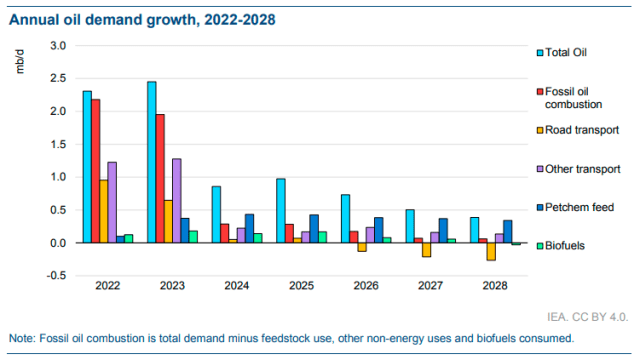The growth in global oil demand is expected to slow down significantly in the coming years, according to a recent report by the International Energy Agency (IEA).
The global energy crisis, driven by high oil prices and concerns about supply security, has accelerated the transition towards cleaner energy technologies.
The IEA’s Oil 2023 medium-term market report predicts that, based on current government policies and market trends, global oil demand will increase by 6 percent between 2022 and 2028, reaching 105.7 million barrels per day (mb/d). This growth will be supported by strong demand from the petrochemical and aviation sectors. However, despite this overall increase, the annual demand growth rate is projected to decline from 2.4 mb/d this year to only 0.4 mb/d in 2028, indicating that peak demand is on the horizon.
In particular, the use of oil for transportation fuels is expected to decline after 2026 due to the expansion of electric vehicles, the growth of biofuels, and improvements in fuel efficiency, all of which will reduce oil consumption.
IEA Executive Director Fatih Birol emphasized that the shift towards a clean energy economy is gaining momentum, and global oil demand is expected to peak before the end of this decade as electric vehicles, energy efficiency measures, and other technologies continue to advance. Birol also stressed the importance for oil producers to closely monitor the accelerating pace of change and adjust their investment decisions to ensure a smooth transition.
Global oil markets are still recovering from the upheaval caused by the Covid-19 pandemic and Russia’s invasion of Ukraine. The resulting global energy crisis has led to significant disruptions in global trade flows. While the production cuts by the OPEC+ alliance have helped temper the surge in global oil supplies, the strains on the market are expected to ease in the coming years, as outlined in the report.
China, which lifted its strict Covid-19 restrictions at the end of 2022, experienced a rebound in oil demand in the first half of 2023. However, demand growth in China is projected to slow significantly from 2024 onwards. Nevertheless, the growth in petrochemical demand and consumption in emerging and developing economies will more than compensate for a contraction in advanced economies.
Investments in oil and gas exploration, extraction, and production worldwide are on track to reach their highest levels since 2015, with a projected 11 percent year-on-year growth to USD 528 billion in 2023. While this increased spending will be partially offset by cost inflation, if sustained, it will be sufficient to meet the forecasted demand within the report’s timeframe. However, this level of investment exceeds what would be required in a world that is on track for net zero emissions.
The report assumes that major oil producers will continue to expand their capacity, even as demand growth slows down. As a result, there is expected to be a spare capacity cushion of at least 3.8 mb/d, primarily concentrated in the Middle East. However, the report acknowledges several factors that could affect market balances in the medium term, including uncertain global economic trends, decisions made by the OPEC+ alliance, and China’s refining industry policies.
Non-OPEC+ oil-producing countries dominate the plans for increasing global supply capacity in the medium term, with an expected rise of 5.1 mb/d by 2028, led by the United States, Brazil, and Guyana. Within the OPEC+ alliance, Saudi Arabia, the United Arab Emirates, and Iraq are leading the efforts to build capacity, while African and Asian members are expected to struggle with ongoing declines, and Russian production is declining due to sanctions.

